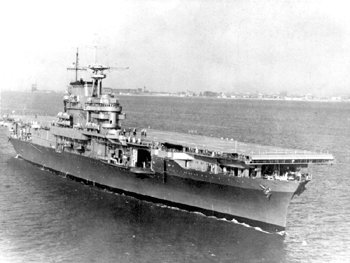 |
|
|
The WW2 Aircraft Carrier
USS Hornet CV-8 Model Ships.

You are in the
USS
Hornet Model Ship section.of
the Ship Model Department.in the YellowAirplane store.
Model Kits of the USS Hornet WW2 Aircraft Carrier CV-8.Model Kits. The USS Hornet had a displacement of 19,800 tons. The Aircraft Carriers Length was 809 feet 9 inches. The beam or width of the ship had an extreme width at flight deck: 144 feet. The Hornets draft or maximum depth in the water was 21 feet 8 inches. The USS Hornet had a max speed of 33 knots. Her crew complement was 1,889 crewmembers. For armament the USS Hornet had 8 five-inch guns and 16 1.1-inch guns. Aircraft Carrier Class: Hornet Please, as time moves on modifications are always added and the weight and exact sized of the ship will continuously change. The USS Hornet (CV-8) was launched on the 14th of December 1940 by the Newport News Ship Building & Dry Dock Co. in Newport News, Virginia. It was sponsored by Mrs. Frank M. Knox the wife of the Secretary of the Navy. The USS Hornet Aircraft Carrier was commissioned at Norfolk Naval Shipyards on 20 October 1941 with Captain Marc A. Mitscher in command.
USS Hornet CV-8 1/350 Scale Models |
|
Survival Equipment - Survival Supplies Sports Cars for Sale
USS Hornet CV-8 Aircraft Carriers.
|
|
|
USS Hornet CV-8 1/350 Scale Models
USS Hornet CV-8 1/700 Scale Models
USS Hornet CV-8 & CV-12 Cruise Books
USS Hornet Decals & Window Stickers
USS Hornet CV-8 & CV-12 Shoulder Patches
|
|
|
|
|
| USS Hornet CV-8 Study Notes |
|
The USS Hornet (CV-8) History. The 1941-1942 version USS Hornet, was a 19,800 ton Yorktown class aircraft carrier constructed at Newport News, Virginia. Commissioned in October 1941, she spent the next four months in the Atlantic preparing for battle. Transferred to the Pacific in March 1942, the Hornet was immediately deployed for the Doolittle raid. On 18 April 1942 she launched 16 U.S. Army B-25 bombers to attack Japan, a strike that caused relatively little damage but which had enormous strategic implications. The Hornet was then sent to the South Pacific to reinforce U.S. units following the Battle of Coral Sea, but was recalled to Pearl Harbor in mid-May. She then took part in the Battle of Midway, on 4-6 June 1942 during which her aircraft assisted in the sinking of the Japanese cruiser Mikuma. In August 1942, the Hornet returned to the South Pacific to join the fight for Guadalcanal. During much of September and October, she was the only operational U.S. aircraft carrier available to oppose the Japanese in that area. On 26 October 1942, during the Battle of the Santa Cruz Islands, her planes attacked and badly damaged the Japanese carrier Shokaku. In return, however, the Hornet received heavy bomb and torpedo damage, necessitating her abandonment. Though accompanying U.S. destroyers attempted to scuttle her, she remained afloat until torpedoed and sunk by Japanese ships early in the morning of 27 October.
The Hornet first sailed in 1942 and gained fame when "Doolittle's Raiders" launched from her deck in their B-25s. The Hornet survived 372 days before sustaining heavy damage, and ultimately sinking, at the Battle of Santa Cruz. history of CV-8 from launching to final moments at Santa Cruz; extensive footage of the Doolittle Raid and the Battle of Midway; Navy Secretary Knox's speech at the launching of the new Essex-class Hornet (CV-12); even the recovery of Apollo 11 and 12 America's two great fighting ships named Hornet: CV-8 and CV-12. USS Hornet CV-8 Aircraft Carrier Product Description
The Hornet was then sent to the South Pacific to reinforce U.S. units following the Battle of Coral Sea, but was recalled to Pearl Harbor in mid-May. She then took part in the Battle of Midway, on 4-6 June 1942 during which her aircraft assisted in the sinking of the Japanese cruiser Mikuma. In August 1942, the Hornet returned to the South Pacific to join the fight for Guadalcanal. During much of September and October, she was the only operational U.S. aircraft carrier available to oppose the Japanese in that area. On 26 October 1942, during the Battle of the Santa Cruz Islands, her planes attacked and badly damaged the Japanese carrier Shokaku. In return, however, the Hornet received heavy bomb and torpedo damage, necessitating her abandonment. Though accompanying U.S. destroyers attempted to scuttle her, she remained afloat until torpedoed and sunk by Japanese ships early in the morning of 27 October. Hornet was commissioned in late 1943 and spent the next 27 years on active duty, receiving two refits along the way. She participated in many battles in the Pacific, flew combat patrols during Vietnam and retrieved Apollo space capsules. Since the early nineties, Hornet has had the mission of educating visitors to its museums about the past. It is a popular tourist attraction in Alameda, California. This kit features a full hull, display stand, angled deck, armaments, Apollo 11 capsule, aircraft and markings for the ship from 1969.
|
Please note: The background picture on this page was taken when I
was stationed on the
USS Kitty Hawk in 1977-1978 in the Western Pacific.
C. Jeff Dyrek, Webmaster.
Click here to see the USS Kitty Hawk Exhibit
* Belt
Sanders * Glue
Guns * Heat Guns
* Lathes *
Paint
* Vices * Xacto
Knives
|
Take a look at the Yellow Airplane Historical and Technical Museum |
|
|
|
/Models_Ships/Aircraft_Carrier_USS_Hornet.html|41776"
Copyright Dates:
11-21-2010
| . |